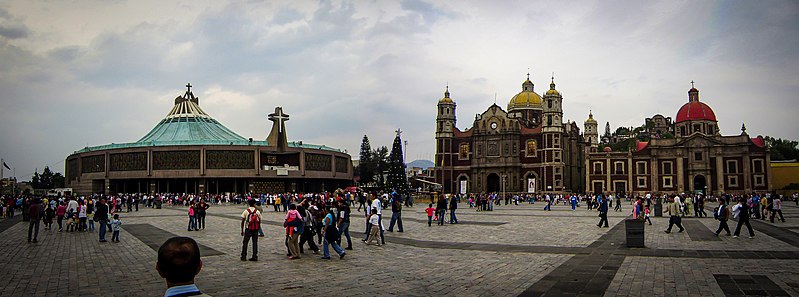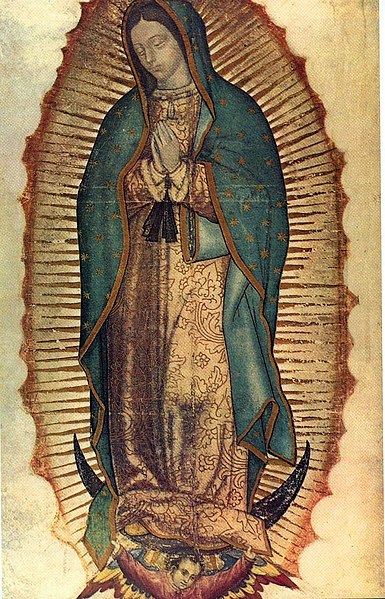A Visit to Tepeyac, Mexico
By Vissia Hernandez
We celebrate the feast of Our Lady of Guadalupe, the secondary Patroness of the Philippines and Protectress of Unborn Children, on December 12. Tepeyac, or the Hill of Tepeyac, Mexico, is where the Blessed Virgin appeared to San Juan Diego in 1531. The shrine of Nuestra Señora de Guadalupe, Our Lady of Guadalupe, is one of the most visited in the world. Vissia Hernandez has written previously for Misyon.
|
|
|---|
‘It’s like Baclaran’, was my first impression, as I got off the city bus. Stores and stalls selling everything from recuerdos y zapatos (souvenirs and shoes) to comidas y bebidas (food and drink) line both sides of a pedestrian area leading to La Villa (‘the town’, referring to the Basilica compound). A brisk five-minute walk away, behind a tall fence, towers an ancient brick church – the old Basilica, with its imposing yellow dome, twin bell-towers and ornate facade.
As more and more people were streaming towards the gates, I qualified my first impression, ‘It’s like Baclaran on a first Wednesday!’ Excitement mounted with each step until I finally reached the gates of La Villa. Inside, folk dancers with tall headdresses and fierce masks were performing a ritual dance. As I surveyed the wide expanse of Plaza Mariana with its many churches and chapels, a baptistery and a small hill, I was reminded of the Marian shrine complexes in Lourdes and Fatima, only this time, the hordes of pilgrims were predominantly Mexican, and the atmosphere familiarly ‘fiesta’. People were carrying around big and small images, even altars and carrozas of their beloved patroness, reminiscent of Filipino devotees cradling treasured Sto Niños in their arms during the January processions. Instantly, I felt at home!

Plaza Mariana with the New Basilica, the Old Basilica and the Temple of the Capuchin Nuns
|
|
|---|
|
|
|---|
As I turned around, there it was, the new Basilica of Our Lady of Guadalupe! My eyes were immediately drawn to the large Spanish inscription above the main door ‘No Estoy Yo Aqui, Que Soy tu Madre?’ (Am I, who is your Mother, not here?)
Misty-eyed, I whispered in gratitude, ‘Mama Maria, your peregrina (pilgrim) is finally here, a week late, but as promised, estoy aqui!’ I hurried into the ‘new’ Basilica shaped like a ‘giant's salakot [2], and was astounded for inside it was huge, cavernous, yet packed to its ‘SRO’ capacity of about 10,000. In a prominent place of honor above the altar, hangs San Juan Diego’s famous tilma (mantle) miraculously preserved through the centuries with its imprint of the Blessed Mother’s image (her only known photograph – developed in color in some celestial darkroom).
Thanks to my phone’s missal app, and remnants of college Spanish, I managed to participate in the lauds and Masses, and even joined in the rousing cheers of ‘Viva El Cristo Rey, Viva Nuestra Señora de Guadalupe, Viva!’ which reverberated throughout La Villa that day. It was the Feast of Christ the King. I later learned that this very Feast was established in 1925 by Pope Pius XI, to fight anticlericalism in Mexico which soon escalated to outright anti-Catholicism triggering the massive rebellion led by the Cristeros. From 1926-1929, tens of thousands were tortured and killed for the Faith, including the 25 Mexican Martyrs canonized in 2000 by Pope John Paul II. ‘Viva El Cristo Rey, Viva Nuestra Señora de Guadalupe!’ was their battle cry, then and now, fiery and full-bodied like their tequila. How providential that I was delayed for a week, or I would have missed all this.
|
Las Manañitas a La Virgen, 12 December 2012, sung in the Basilica after the early morning Mass. Las Mañanitas is a traditional Mexican birthday song, also known in the Philippines, sung to the celebrant very early in the morning. |
|---|
I spent the rest of the day praying and meditating in the many churches and chapels of La Villa de Guadalupe, gazing awestruck at the beloved image on the tilma while standing on walkalators hidden beneath the new Basilica’s sanctuary, and on the side, shopping for recuerdos, taking gigabytes of pictures, and finally, huffing and puffing my way to the top of Tepeyac Hill where a small church stands where the Blessed Virgin first appeared in 1531 to the peasant, Juan Diego. By sundown, while taking in the magnificent view of the Basilicas of Guadalupe, this tired yet extremely blissful peregrina couldn’t thank her gracious Hosts enough for the sense of peace, joy and love which had enfolded her like a tilma throughout her pilgrimage. ¡Gracias, El Cristo Rey. Gracias, Madre mía de Guadalupe!
‘Hear me and understand well that nothing should frighten or grieve you. Let not your heart be disturbed. Do not fear that sickness, nor any other sickness or anguish. Am I not here, who is your Mother? Are you not under my protection? Am I not your health? Are you not happily within my fold? What else do you wish? Do not grieve nor be disturbed by anything.’
-- Message of Our Lady of Guadalupe
|
Himno a la Humildad, sung by Marco Antonio Solís: Con que gusto venimos con gran emoción How we love to come with great feeling Beloved Virgin . . . miraculous, Dark Virgin, Queen of hope, (Spoken) We come here, beloved Mother, with our bodies more tired that the last time, Virgencita adorada, no me puedo ir Dear Blessed Virgin, I cannot leave Dark Virgin, Queen of hope, [Thanks to Fr Jovito Dales for help with the translation.] |
|---|
You may email the author at Vissia_Hernandez@pal.com.ph



